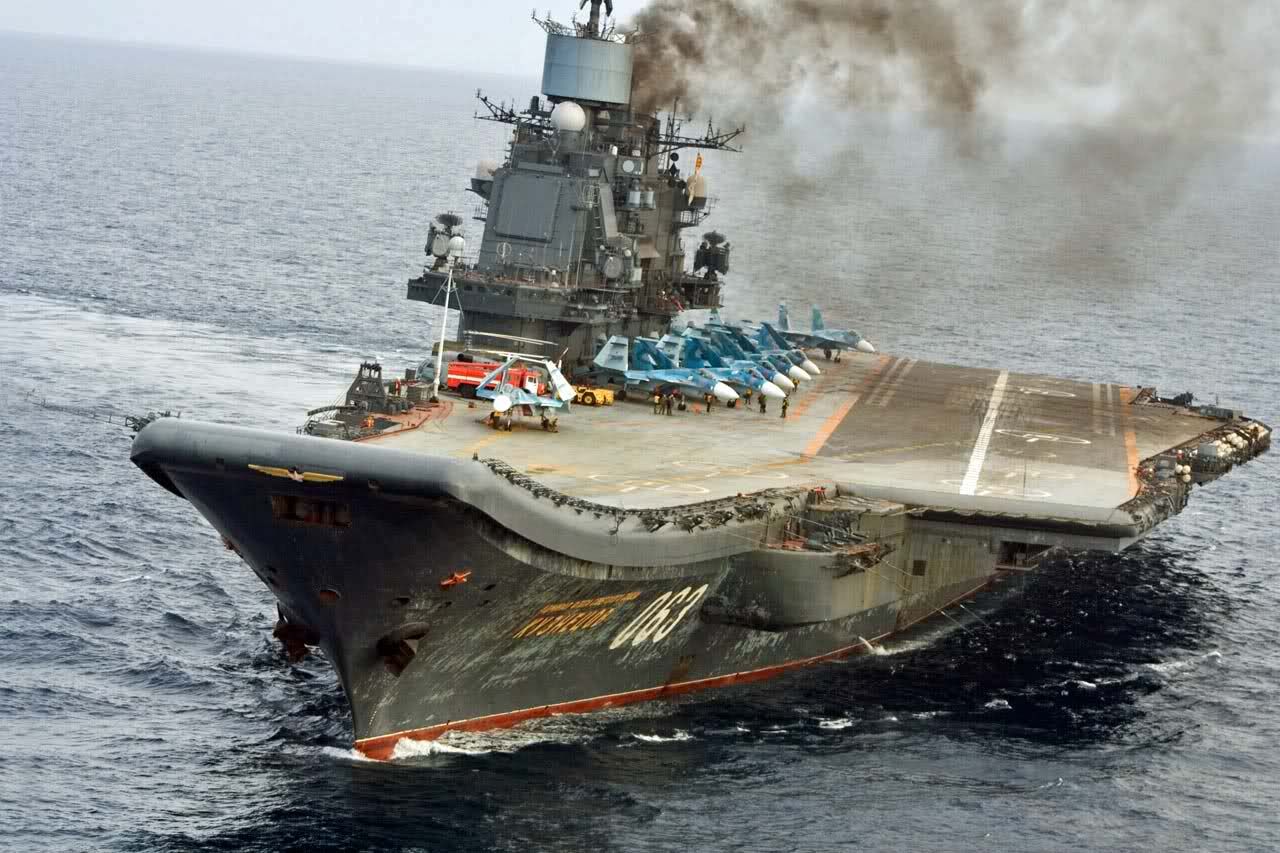Russian Aircraft Carriers - Russia and the former USSR have been some of the most active aircraft carriers in the world since the 1960s. Only the US, UK, Japan and France have more of these ships controlling their waters. Immediately after World War II, many aircraft were sold, scrapped and placed in storage. But as the Cold War really began, almost all of them were put back to work. However, that was a while ago and after the fall of the Soviet Union, many saw the Cold War as finally over and the shuttles were once again removed and put into storage. Today, in 2014, of the aforementioned countries, the US has 19, the UK 2, France 4, Japan 2, and Russia 1 aircraft carrier, which is a much smaller force than before 1991. But back to history: At the beginning In the 1960s, the Americans built one of their most successful aircraft carriers ever, the USS Enterprise, which was the world's first nuclear-powered aircraft carrier. The USSR then saw real potential in having a floating air force base and began developing its own carriers.
The size of the superstructure indicates that this is a cruiser rather than a "true" carrier. Image: Admiral Kuznetsov
Russian Aircraft Carriers

First some terminology. As you can see in the table, the USSR and later Russia called their aircraft carriers "carrier ships". This is no coincidence; there are diplomatic reasons. Russian ships are usually built in the Black Sea, and when they want to go out to the high seas, they have to go through the Dardanelles. But according to a law from 1936, the passage of airplanes is prohibited here. Therefore, the Russians prefer to call their ships instead of ships, so that there is no tension. However, in this article I will stick to the issue of airlines for both US and Russian cars.
Kiev Russian Aircraft Carrier 3d Model
This article will only cover "modern" carriers, meaning carriers built after the USS Midway (launched in 1945). You can read about the previous stages in the construction of airplanes in another article
. Between 1967 and 1991, Russia completed seven airplanes/planes. Evolutions in the weight, length and size of the kit show how much Soviet technology has improved between these years. You can see in the table that the Soviets started much later than the Americans in developing cars and have come a long way since then. Today, the US has more modern, heavier and larger aircraft carriers than Russia. The explanation for the beginning was partly that the military budget of Russia was smaller than that of the US and that the USSR did not think that aircraft carriers could be such effective ships before the Americans showed the success of the USS Enterprise.
The first president of the USSR who thought seriously about the construction of airplanes was Leonid Brezhnev. He thought that the transports could be very useful because they were very flexible and therefore could protect the giant Soviet Union of 22,200,000 km². Thus he led Russia today to the development and commissioning of the Moscow and Leningrad, the only two Moscow cars in the class. But they, as we can see in the table, are not true aircraft carriers, because they only carry helicopters. However, it was very useful at the time because of the possibilities of using helicopters as anti-submarine platforms, as the dawn of nuclear submarines had just dawned.
The next step in the history of Russian carriers is the Eagle project. The Eagle-class destroyers are to weigh more than 5 times the weight of their predecessors, carry 70 fixed-wing aircraft, and be nuclear capable. The plan was to compete with the flagship USS Enterprise, which had proven to be $430 million expensive to build in 1958. However, when the commander who started the project died, a new commander, who was young, more profitable cars arise. to power and the project (which started in '73) was scrapped.
Soviet Aircraft Carriers Review
After Project Eagle was closed, all parts of the fleet agreed that they still needed propellers to provide sufficient air support when at sea. The discussion continued and the last answer was an average: not as big as the Orel, but still a real step up from the (very) small Moskva class. The result? Kiev class. The four aircraft of this class weighed about 40,000 tons each and had a much larger airfoil than the smaller 15,000-ton predecessor. The main difference between the "Kyiv" and Western ships is mostly that since the "Kyiv" are small ships, they are also equipped with heavy weapons such as 76 mm guns, surface-to-surface missiles P-500, up to 200 surface. -to-surface missiles ground air missiles and even torpedo tubes. These bombers received great approval from all corners of Russia and were the cornerstone of further development - although the Yak-38, which was the fixed aircraft of the Kiev bombers, was not well liked.
Kuznetsov classes. The Kuznetsov aircraft carrier was originally thought to be a close improvement of the Kyiv class, but after the Orel project failed and further delays followed, it did not develop as expected. However, in 1981, the current Russian Defense Minister, Dmitry Ustinov, attended an exercise on a Kyiv-based submarine to decide on the issue. The shortcomings he saw made him think: What is the point of having such powerful ships if they are not even similar to the US Navy. So he set Project Kuznetsov in motion, and 14 years after the exercise, in 1995, Admiral Kuznetsov was fully operational (needless to say that the USSR was inactive at the time). It is the first Russian aircraft carrier capable of launching regular launch aircraft such as the Sukhoi Su-27 and the Mikoyan MiG-29. The previous Kyiv class was able to launch their STOVL (ShortTakeOffVerticalLanding) Yak-38 aircraft. Just like Kyiv, Minsk, Novorossiysk and Gorshkov (Kiev cruisers), the new Kuznetsov has heavy weapons on board, making it the new pride of the Russian Navy.
Some of the Russians have sold and disappeared over the years for various reasons. Admiral Gorshkov was very expensive to maintain and used with the Russian Navy after the Cold War. So she was sold to India, repaired and refitted in 2013 under the name INS Vikramaditya. It is currently one of two active Indian carriers. The Varyag carrier (seen in the table) was also annexed by Ukraine after the Cold War. It was removed from all electronics and later was taken off (body only). The winning bid came from a Hong Kong businessman who wanted to build a casino in Macau. This did not happen, the ship eventually ended up in dry dock in Dalian and became the Liaoning, a Chinese carrier.

Ulyanovsk, which appears last in the table, is also a project of the USSR. It was basically the Orel hull equipped with advanced weapons and electronics. This idea was also rejected, but its models were sold to China, which plans to use them in the construction of future generations of carriers. Gear obsessed editors pick every product we review. We may earn a commission if you buy from a link. Why trust us?
Nevskoe Design Bureau Details Aircraft Carriers, Lhd Projects
Lost his second fighter jet in just three weeks. The latest incident, involving the Su-33 Flanker air superiority fighter, is also the second involving the failure of the vehicle's barrier cables. The aging carrier has experienced a series of inefficiencies and equipment shortages over the past few years.
According to The Aviationist, on Saturday, December 5, the Su-33 Flanker twin-engine fighter made a second attempt to land on the plane of the airline. The first attempt was a "bolter" - a tail hook in which the fighter failed to hook a safety rope designed to catch the aircraft and place it safely on the deck. Russian state media said the plane caught the rope on its second attempt to land, but the rope broke. The pilot got out of the plane and the Navy plane took off.
On November 14, on the first day of the aircraft carrier's flight over Syria, a MiG-29K jet crashed on landing. In this event, the MiG crashed after being forced to stop due to the failure of another barrier cable. While waiting for the carrier's crew to fix the mess, the MiG suddenly lost power to both engines and the pilot was forced to eject.
Cable damage is not uncommon - the braided steel cables are designed to stop a 40,000 pound Su-33 Flanker in just 350 feet. On US flights, the landing gear cables are replaced after about every 100 successful landings. We don't know how often the Russians change their cables, but there is growing evidence that they don't change them often. durable.
Russia Should Ditch Its Cursed Aircraft Carrier And Focus On Its Two New Amphibious Assault Ships
Air Wing, 100th Independent Carrier Fighter Aviation Regiment, on the ground at Humayim Air Force Base in Syria. That was probably the reason
0 Comments